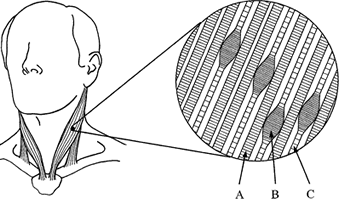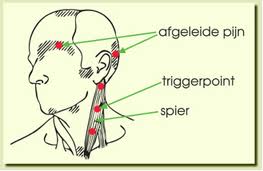The theorie is that they are tiny contracted "knots" that develops in a muscle when it is injured or overworked. The defining symptom of a trigger point is referred pain; that is, trigger points usually send their pain to some other site. This is an extremely misleading phenomenon and is the reason conventional treatments for pain so often fail.
Muscle fibers act like tiny pumps by contracting and relaxing, to circulate blood through the capillaries that supply their metabolic needs. When fibers hold their contraction, blood flow essentially stops in the immediate area. The resulting oxygen starvation and accumulation of the waste products of metabolism irritates that area. It responds to this emergency by sending out pain signals.
What causes it:
- Most important cause is chronic overloading of muscles in work situations
- Repetitive strain or motion
- Static habitual muscle tension
- Overweight
- Physical factors like unequal leg lenght and an asymmetric pelvis
- Postural stress by chairs, couches and car seats
- Tension, anxiety and everyday nervousness
- Sudden or direct impact or trauma (falls, collisions, due to overstretching or
overcontracting, surgery)

Symptoms:
The defining symptom is referred pain. Characteristically, referred pain is felt most often as an oppressive deep ache, although movement can sharpen the pain.
Problems with movement: movement requires some muscles to contract and othes to lenghten. Movement irritates trigger points and increases pain, making you less and less inclined to move.
For example if your neck hurts, you stop turning your head to keep the muscles from suffering further abuse.
This calls other muscles into action to take up the burden, but these muscles are bound to get stressed from doing the ackward, unaccustomed work, And very soon they develop trigger points too. The range of motion becomes progressively limited.
Untreated trigger point that go on for months or years can really drag your spirits down.
Chronic pain is a well-known cause of depression, especially if you’ve been told it’s untreatable.
Sleeplessness and chronic fatique are other very common symptoms, because they keep you from resting.
Muscles that have been shortened and enlarged by trigger points frequently squeeze nearby nerves. This can distort the electrical signals that travel along it, resulting in abnormal sensations such as numbness, tinling, burning and hypersensitivity in the areas served by the nerve. This is a very common occurrence in the arms and hands.

Treatment:
Deep, short stroking massage applied in one direction, no static pressure. It relaxes the muscle fibers and cleans the tissue from metabolic waste.
What is the positive effect:
They hurt when compressed, but you have to realise that pain created by massage is beneficial. The electrical impulses disrupt the neurological feedback loop that maintains the trigger point; you are feeling better, certainly with less pain and better mobility. Especially after severals treatments.
Another positive effect of pain from massage is that it immediatly brings a flood of painkilling endorphins. For this reason, you’ll find that the longer you work on an area, the more pressure you will be able to use and to work deeper with far less discomfort.
Source: Triggerpoint therapy manual by Clair Davies
